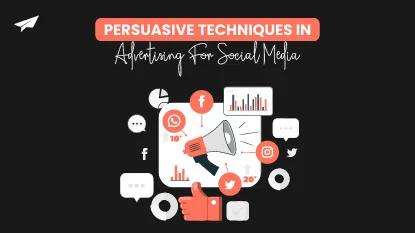Persuasive Techniques in Advertising For Social Media
Persuasive Techniques in Advertising For Social Media have become a powerful tool for e-commerce growth. To cut through the noise and capture the attention of potential customers, businesses must employ persuasive techniques in advertising for social media campaigns. In this blog with Tekglide, we will explore the significance of persuasive techniques in advertising, their role in social media, and how they can help you achieve marketing success.
How Do Persuasive Techniques in Advertising in Social Media Campaigns Play A Role?
In social media, content is the Harry Potter, and persuasive advertising is the Hermoine Granger of the social media world. The main goal of any advertising campaign on platforms Facebook, Instagram, and Twitter is to persuade users to take a specific action. This could range from anything purchasing a product to signing up for a newsletter.
Persuasive Marketing in social media advertising involves a combination of factors. Firstly, it’s mandatory to understand your target audience and customize the content to their needs and desires.
Leverage Reviews and Testimonials in Social Media Advertising
Reviews and testimonials can be a potent persuasive tool on social media. Positive feedback from loyal and happy customers can build trust. Incorporating these reviews into your ad campaigns can influence the decision-making process of potential customers.

The Power of Storytelling in Advertisements
Storytelling in advertisements is another effective persuasive technique. By introducing a narrative into your advertising content, you can connect emotionally with your audience. A well-crafted story helps potential customers relate to your brand and product, making them more likely to engage and convert.
Targeted Marketing
Targeted marketing, also known as audience segmentation or niche marketing, involves customized marketing efforts to reach a specific group of people interested in your product or service. The idea is to focus your resources, messages, and advertising campaigns on the audience segments. In social media advertising, one size doesn’t fit all. Tailoring your ads to specific demographics and interests can significantly boost your persuasive efforts. Targeted marketing ensures that your message reaches the right people, increasing the likelihood of conversion.
Strategies for Effective Target Marketing
Market Research: Market research helps to understand your audience. Collect demographic, psychographic, and behavioral data to create detailed customer personas.
Segmentation: By dividing into segments based on population characteristics, such as age, location, interests, and behavior. Consider creating different buyer personas to represent each segment.
Tailored Content: Create content and messages that are specific to each segment. For example, if you’re selling sports equipment, your content for a segment of fitness enthusiasts might focus on performance, while content for a segment of parents might highlight safety and durability.
Use of Data: Utilize data analytics and marketing automation tools to track the behavior of your audience and adjust your strategies accordingly. This can help you identify changing trends and adapt your campaigns in real time.
The Power of Visuals
Visual content in persuasive advertising in the digital age, holds significance over consumer behavior. Visuals are so influential, and how you can harness their power in your social media advertising campaigns:
- Immediate Impact: Visuals can instantly grab attention on social media. Compelling images or videos can stop users mid-scroll and deliver your message in seconds.
- Emotional Connection: Visuals evoke emotions to create an emotional connection with your audience. Emotional marketing is powerful – tap into your viewer’s feelings and desires. A heartwarming image generates trust and warmth.
- Simplified Communication: Visuals make it easy to communicate complex ideas or concepts.
- Storytelling: Visuals can be a core component of storytelling in advertising. They can narrate a compelling story, taking the viewer on a journey. Storytelling engages the audience, making them more likely to remember your message and take action.
- Brand Identity: Consistent visual elements, such as logos, colors, and typography, contribute to your brand’s identity. When users consistently see your brand’s visual elements on social media, they are more likely to remember and trust your brand.
The Role of Emotional Marketing in Persuasion
Emotional Marketing’s role in consumer decision-making is by connecting the emotions of your audience, you can create a deeper connection with your customers. Whether it’s joy or empathy, emotions can be used to influence and persuade.
Incorporating emotional marketing in your social media ads can result in higher engagement metrics and conversion rates. For example, an ad that appeals to their sense of belonging can motivate them to become part of your community.

Highlight Engagement Metrics
Highlighting engagement metrics is essential in assessing the effectiveness of your social media advertising. The number of likes, shares, comments, and clicks on your ads can indicate how persuasive your content is. High engagement metrics often translate into better conversion rates.
Benefits of Conversion Rate
- Measuring Effectiveness: The conversion rate measures how many potential customers become actual customers through advertising. A high rate means your persuasive techniques are working.
- Optimizing Campaigns: Tracking conversion rates helps you identify successful marketing campaigns. This data enables you to allocate resources more efficiently.
- Predictive Insight: Conversion rate data helps predict future performance. Analyzing trends and patterns enables informed decisions on resource allocation, strategy refinement, and campaign scaling.
How to Calculate Conversion Rate
How to calculate conversion rate is the percentage of people (the “conversion”) out of the total number of people who had the opportunity to take that action (the “visitors” or “clicks”). Here’s the formula:
Conversion Rate (%) = (Number of Conversions / Total Number of Visitors) x 100
For example:
You have an e-commerce website, and to calculate the conversion rate for a product page. 2,000 visitors viewed the product page, and 100 of them made a purchase. To calculate the conversion rate:
Conversion Rate (%) = (100 / 2,000) x 100 = 5%
So, in this case, your conversion rate for the product page is 5%.
Track and analyze conversion rates to improve marketing. Achieve better results by optimizing digital campaigns based on insights gained.
Conclusion
In conclusion, persuasive techniques in advertising for social media advertising is essential. To understand the importance of persuasive techniques in advertising is the first step to explore the full scope of your marketing campaigns. Leverage reviews and testimonials, incorporate storytelling, highlight engagement metrics, calculate your conversion rate, practice targeted marketing, harness the power of visuals, and tap into the emotions of your audience to create compelling, persuasive content.
Combining these strategies can enhance your social media advertising efforts, drive more conversions, and ultimately achieve marketing success. As social media continues to evolve, so too should your approach to persuasive advertising.
So, start employing these techniques today, and watch your social media advertising campaigns reach new heights of success.





